| 1 | Spotted lancehead |
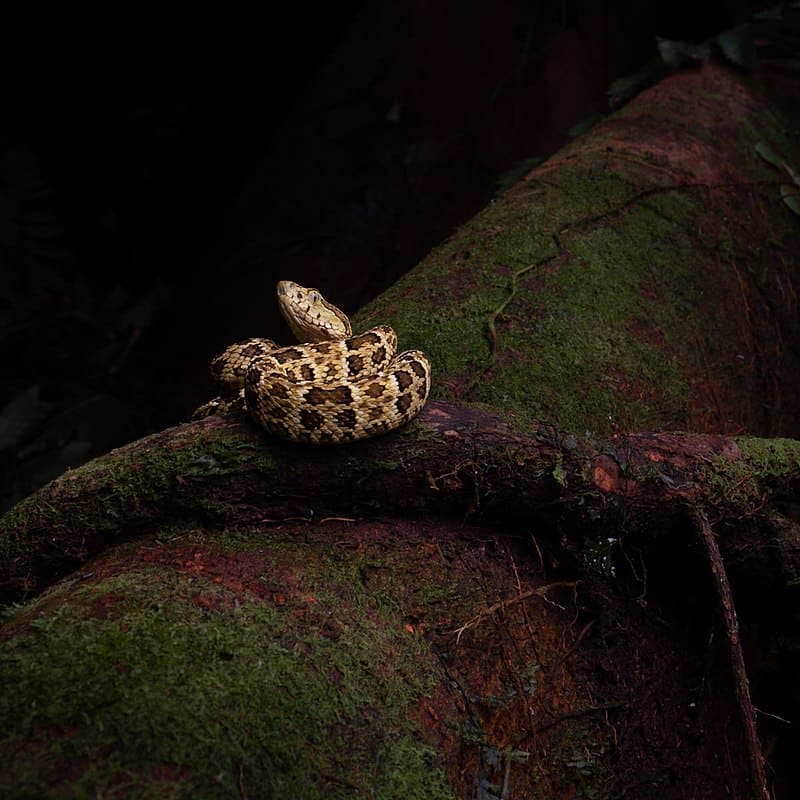
This venomous snake lives in only two countries: a swathe of northwest Ecuador and a small portion of southern Colombia. The spotted lancehead (Bothrops punctatus) reaches a maximum of 130cm, and is uncommon within its range, being tucked away in old forests where it waits in ambush for prey. Its main region is the Chocoan lowlands, with the Canandé Reserve, Itapoa Rainforest Reserve, and Tesoro Escondido Reserve being particular hotspots. Its range also extends to Ecuador’s Pacific coast.
Spotted lanceheads aren’t especially deadly, as its venom has an LD50 rating of 2.4mg, with an average injection of 34.4mg per bite. Its venom has less local symptoms than others, and specialises in coagulopathy, AKA blood clotting chaos with uncontrollable bleeding. This viper has a prehensile tail capable of grasping branches, and while not exclusively tree-dwelling, they’ve been spotted 18 metres high in the air.
Spotted lanceheads have a triangular head with a very thin neck. While a swathe of their forest heartland has been cut down, spotted lanceheads are widespread enough to not be under serious threat. The best way to find Bothrops punctatus is to walk along forest trails at night with a torch, but the odds are always small that you’ll actually meet one.
| 2 | Painted marsh snake |
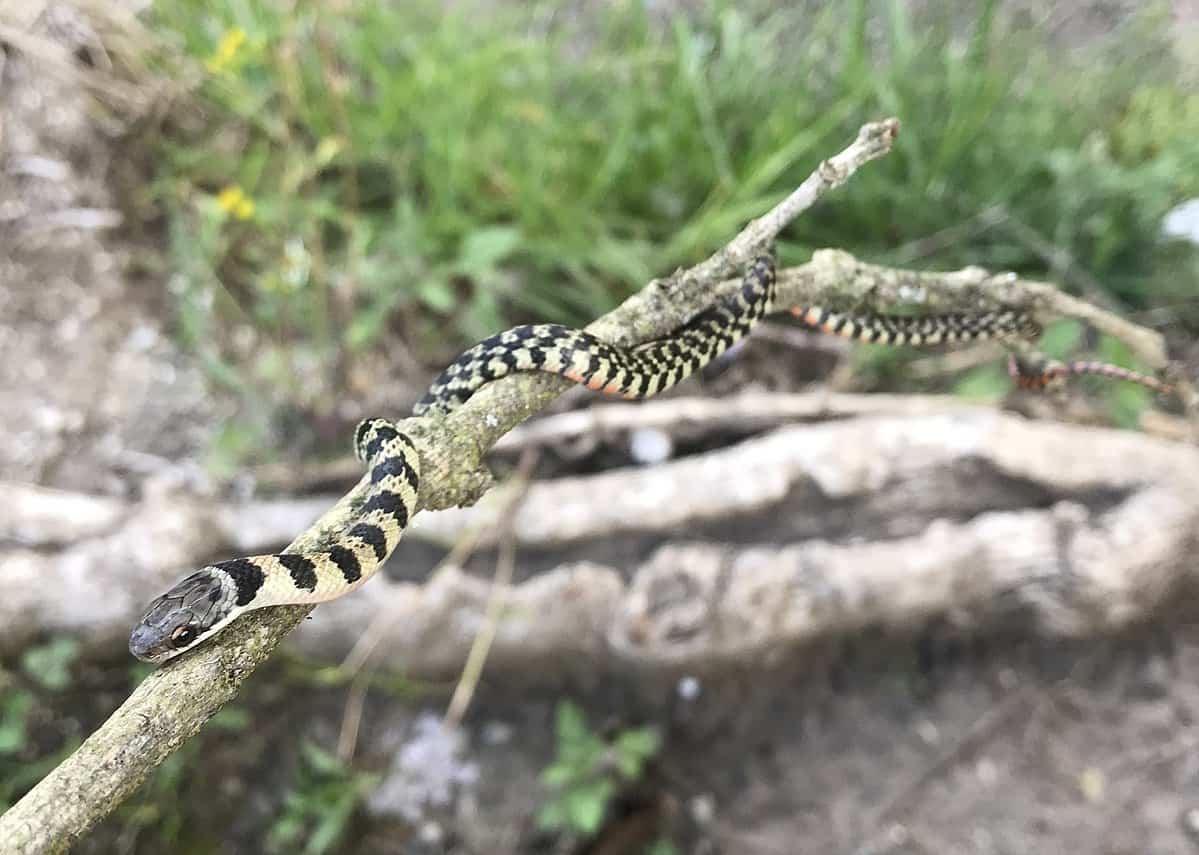
This harmless snake lives in northern Ecuador, on the western slopes of the Andes, and in valleys within the Andes itself. It’s a high altitude snake, sticking to between 1600 and 3000 metres above sea level. Forests are their home, but painted marsh snakes are also happy in man-altered environments, with a mixture of pasture land, rural gardens and remnants of older vegetation.
Painted marsh snakes (Erythrolamprus vitti) lack venom and have a calm temperament, normally fleeing when approached. This is a day-faring snake which hides beneath leaf litter and soil when not active. They don’t even constrict their prey, instead forming a couple of loose coils to hold them in place while they swallow.
Painted marsh snakes reach a record of 62.7cm. One confirmed prey is the tropical lightbulb lizard, which is endemic to the Andes slopes of Ecuador. Amphibians are confirmed as well, namely the toad Osornophryne occidentals (another Ecuador exclusive). The painted marsh snake is most common in the northerly province of Carchi, where it crosses the border into extreme southern Colombia. Supposedly, you have a 8-10% of chance of finding this snake if you search near the town of Chilma Bajo for 4 hours.
| 3 | Osborne’s lancehead |
Another venomous menace which doesn’t actually bother the Ecuadorian people too much. Osborne’s lancehead (Bothrops osbornei) is the sister species to the spotted lancehead, and another inhabitant of old growth forest. Osborne’s lancehead lives significantly further south, and is confined solely to central Ecuador, unlike the spotted lancehead which crosses into southern Columbia.
Osborne’s lancehead reaches a maximum of 140cm, which is slightly longer than its cousin. The colours can be similar at first glance, but Osborne’s lancehead has trapezium shaped patterns, while the speckled lancehead has small dots arranged into squares. There’s an estimated 7.6% genetic divergence between the two.
As a youth, Osborne’s lancehead feeds on local frogs such as the Cachabi robber frog, before moving onto rodents when they mature, using ambush tactics as they wait on rocks. Juveniles have a brighter, yellower colour scheme which darkens into beige and brown in adulthood. Osborne’s lancehead is active at night and dusk, and is semi-arboreal, climbing to tree heights of 3.5 metres. With an LD50 score of 2.6 mg, its venom is slightly weaker than the spotted lancehead’s. Nevertheless, the bite can unleash necrosis and intense pain.
Osborne’s lancehead is unfortunately in danger, as its heartlands were old forests, some of which were untouched for thousands of years. On the western slopes of the Andes, over 50% of their habitats may have been slashed down.
| 4 | Cope’s tropical racer |
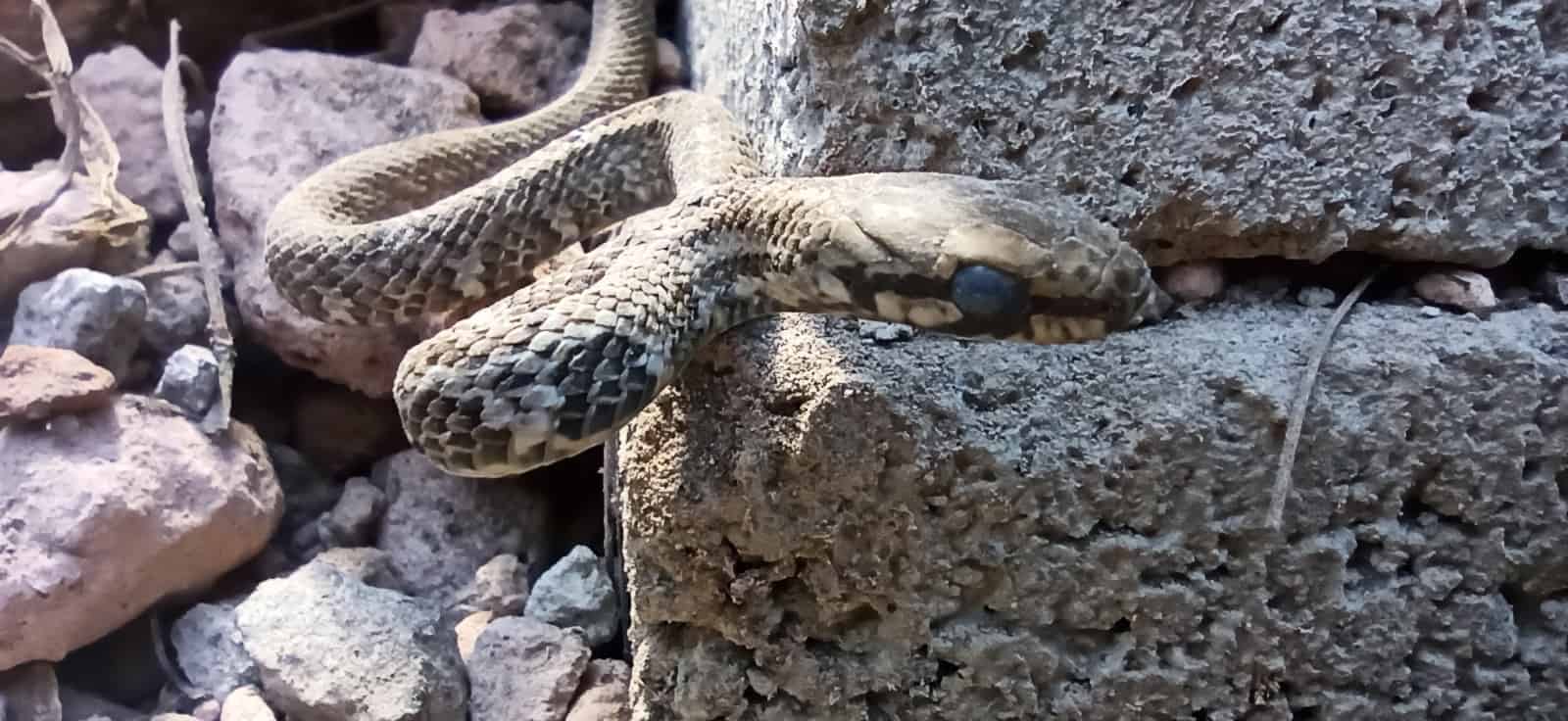
This species inhabit most of the western half of the country, from the spine-like Andes mountain range to the Pacific coast, ranging from altitudes of 0-3500 metres. Copeland’s tropical racer is a 100-150cm snake (max 153.1cm) which is non-venomous, but can quickly turn snappy if pushed.
Rather than forests, Copeland’s tropical racers (Mastigodryas pulchriceps) are most commonly spotted crossing trails and roads, in areas with plenty of vegetation on either side. They’re particularly abundant in the Canandé and Otongachi Reserves, and their appearance transforms with age. Youths have a viper-esque pattern, which is probably designed to mimic them and scare off predators with a terrifying “venom”. But as adults, they become far more elegant, with pale yellow scales interspersed with metamorphosizing sheens of orange.
This snake is hardy and copes well with human activity. It’s one of the few snakes to inhabit the Ecuadorian capital of Quito, and the adjacent valleys. Copeland’s tropical racers are safe from extinction, as they’re plentiful in at least a dozen protected areas of Ecuador. Frogs are on their menu, but most of their prey recorded so far is reptiles: ocellated Andean lizard, Chota whorltail iguana, Quito whorltail iguana.
| 5 | Bailey’s blind snake |
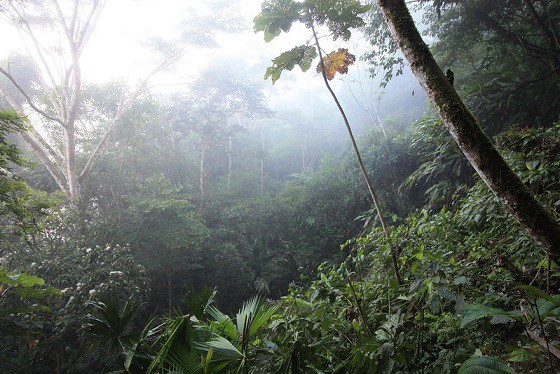
Perhaps one of the rarest snakes in the world. Bailey’s blind snake (Trilepida anthracina) lives solely in Ecuador, and is rarely seen by humans, as it spends most of its life in underground tunnels. Almost all records of this species come from the Pastaza river valley of central Ecuador, on the eastern side of the Andes. Searching for this snake would be a fool’s errand – most individuals so far have been found purely by accident.
Bailey’s blind snake is tiny. Its record length is just 29.3cm, and hence, it probably preys on insects and termite larvae, although nobody is certain, as research is severe lacking. This species looks more like a scaleless worm than a snake, and its eyes are like the dots of a black pen.
Bailey’s blind snake mostly inhabits cloud forests and evergreen forests, usually old growth, but they can withstand moderate levels of human disturbance. While mostly an underground dweller, they sometimes crawl along the forest floor, or even roads. Being so tiny, there’s always a chance that Trilepida anthracina is more common than people believe, and managing to hide under everyone’s nose.
| 6 | Lojan’s lancehead |
This third venomous Ecuadorian snake is an entirely different proposition to the first two Bothrops members. It’s a more distant relative and lives much further south, inhabiting the Andes mountains near the Peruvian border.
Lojan’s pitviper (Bothrops lojani) sticks to altitudes of 2000-2750 metres, and is common in highland grasslands, shrublands, tropical montane forests, gardens and pasture land. They only really avoid areas with zero vegetation, such as towns or modern, mechanized farmland. This is a day-faring viper, a diurnal snake which is rarely seen on the move later than 7:00pm (although as late as 10:00pm has been sighted).
Lojan’s lancehead is an unpredictable species. Some will wiggle their tail in leaves and make a warning noise when threatened, but others will mindlessly attack. Its venom is a total mystery, as there are no scientific studies or detailed reports. The name references the southern Ecuadorian city of Loja, where this species was originally found.
Lojan’s lancehead is an ambush predator which feeds on rodents and lizards. They sometimes lurk on agave plants, Puya plants, or in crevices on the ground. At a maximum of 61cm, Bothrops lojanus is significantly shorter than the two Bothrops members of northern Ecuador.
| 7 | Ribboned brittle snake |
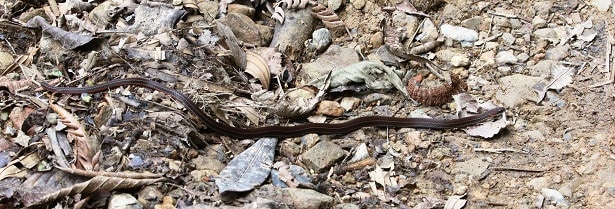
One of the harder snakes to find in Ecuador. The ribboned brittle snake (Urotheca lateristriga) is a slightly venomous species, which isn’t able to inject 50mg with one sudden bite, but chews in a weak venom which can eventually unleash moderate pain and swelling.
Ribboned brittle snakes inhabit almost the entire northwest of Ecuador, including the Andes foothills and Pacific coast, but are very shy and like to lurk below leaf litter in forests. The heart of its empire is a town (and region) called Mindo. From a distance, this species looks like a basic brown snake, with a thin white line on each flank. But up close, the brown becomes more complex, with vivid shades of red and black manifesting before your very eyes.
Their belly is a red-orange colour, while their tail is unusually long, making up 22-33% of their body. The Latin name, Urotheca lateristriga, refers to this long tail (oura is Greek for tail).
Ribboned brittle snakes are also capable of snapping their tail off when bird predators seize them in their talons, which happens often given their small size. The average length is 50cm, and the all-time record was 62.2cm, recorded in 2017. Combined with a weak venom, it’s not surprising that this snake is so keen on staying hidden.
| 8 | Andean snail eater |
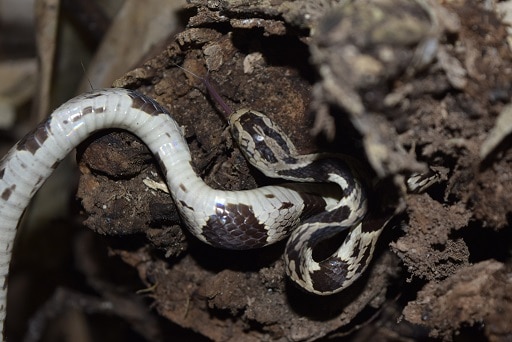
This harmless serpent reaches a maximum of 84.3cm. Dipsas andiana has an extremely blunt, prominent head, almost like the handle of a whip. Several other Dipsas (snail eater) members live in Ecuador, but the Andean snail eater (Dipsas andiana) is the only one with a distinctive U-shaped marking on the back of its head.
This is a forest dweller, and often pops up in banana and coffee plantations. Andean snail eaters have even been found in banana boxes shipped overseas by cargo vessels. If you ever find one crawling out of your shopping trolley in London or Berlin, then it almost certainly originated from Ecuador, as aside from a tiny portion of northern Peru, that’s the sole country they inhabit (unlike the far more widespread Dipsas indica).
Within their habitats, Andean snail eaters stick closely to streams. They crawl along the ground, but also climb to branch perches 10-300cm high. Their goal is to find snails, and they’re not fussy about which ones they swallow, even feeding on introduced giant African snails.
Dipsas andiana is quite easy to find during December-May (rainy season). They mainly come out at night, and their hotspots include the Mindo and Buenaventura biological reserve, and Mashpi rainforest reserve.
| 9 | Hooded centipede snake |
The hooded centipede snake is a 30cm species (max 42.8cm) with no venom. It belongs to the widespread Tantilla genus, which also includes Tantilla oolitica from Florida. This humble Ecuadorian snake mostly dodges the Andes and sticks to the lowlands of western Ecuador, reaching as far west as the Pacific coast. They also cross the southern border into Peru, though Ecuador is clearly their base.
The hooded centipede snake (Tantilla capistrata) is rare, usually appearing no more than every few months at any given location. However, their habitats are flexible – their elusiveness is down to their burrowing, semi-fossorial habits instead. Hooded centipede snakes can make their home in dry forests, shrubland, cattle fields, and rural gardens. They’re sometimes found beneath logs and timber, and their first instinct when startled is to dig furiously.
Another defensive strategy is poking people with their sharp tail. Hooded centipedes are red on almost their entire body, except the head, where a black hood and stripes begin. Its head is barely distinguishable from its neck, similarly to most burrowers.
| 10 | Hudson’s coffee snake |
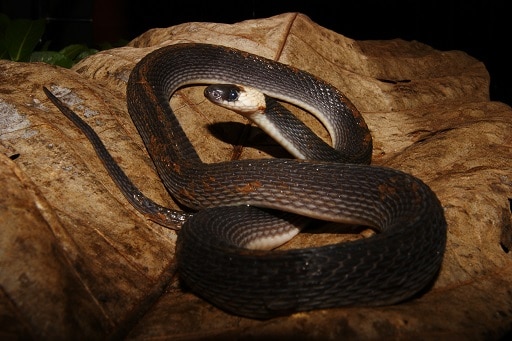
This mostly brown snake is simple to distinguish from others in the Ecuadorian Amazon, mainly due to their snowy white neck scarf, which contrasts sharply against a chocolatey body. Hudson’s coffee snake varies in frequency, as they’re rare in many places, but surprisingly abundant in others.
Hudson’s coffee snake (Ninia hudsoni) peaks at just 49.4cm. Unlike the rest of our list, this species mostly inhabits eastern Ecuador, on the opposite side of the Andes mountain range. The only thing Ninia hudsoni needs to thrive is vegetation. Hence, they appear in evergreen forests, but also plantations, gardens and pastures.
Hudson’s coffee snake is very timid, even when picked up. Their usual defensive move is to duck their head into a shield of coils. They’re believed to feed on slugs and earthworms, like their fellow coffee snakes, and are confirmed prey themselves for larger snakes such as Clelia clelia and Hemprich’s coral snake.
Hudson’s coffee snake has keeled (rough) scales to touch, and its belly is pristine white, contrasting sharply against the black-brown. This 40cm snake is found crawling along forest floors rather than high in trees.
